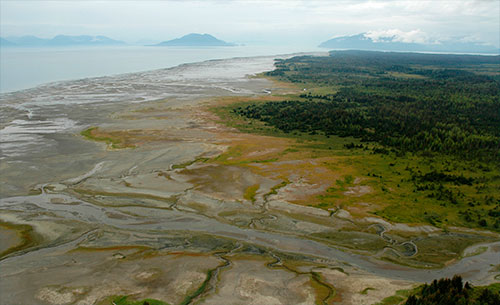The second project, in Gustavus Alaska, will see a 60-foot glulam timber bridge installed over the Harry Hall Creek, a tributary of the Good River. |
Williams said, "In addition to providing benefits for fish and aquatic species, the National Fish Passage Program’s work to restore degraded and fragmented aquatic habitats decreases public safety hazards, improves infrastructure resilience, and creates jobs, stimulating the local economy."
These are the first projects to break ground of 40 fish passage projects funded through the Bipartisan Infrastructure Law in fiscal year 2022. In total, the Law makes a $200 million commitment over the next five years to removing in-stream barriers, restoring rivers and conserving our nation’s aquatic resources under the National Fish Passage Program.
The first project to break ground, a bridge over the Little Tonsina River in the Valdez-Cordova Borough, will open more than 70 miles of salmon habitat with $1.3 million from the Infrastructure Law. This project will remove an undersized, double barrel culvert on the Little Tonsina River and support the creation of a two lane, 100-foot bridge spanning the channel and floodplain on Burma Pit Road near mile post 74.2 of the Richardson Highway. The new bridge will utilize the Service’s comprehensive?Alaska design guidelines for building road-stream crossings that have fish and flood resiliency in mind.
During a storm in 2006, the site’s existing bridge and river culvert were overwhelmed and washed downstream, where they still sit in the riverbed today. Removing the old culvert and replacing the existing bridge will open up 70.4 miles pristine Coho and Chinook Salmon spawning and rearing habitat that lie above this barrier which eventually meet Alaska’s Copper River, one of the world’s most important sources of salmon.
The Little Tonsina River project is a partnership between the U.S. Fish and Wildlife Service, the Copper River Watershed Project, the Chugach Alaska Corporation, the State of Alaska, Bureau of Land Management, Natural Resource Conservation Service, NOAA Fisheries, and The Denali Commission.(Read more)
The second project, in Gustavus Alaska, will see a 60-foot glulam timber bridge installed over the Harry Hall Creek, a tributary of the Good River. The bridge will replace an existing culvert that has become too elevated, impeding fish passage - and is the last of eight other bridges to be set as part of a 10-year effort to reconnect the river’s entire watershed. This will complete the effort to provide unimpeded access to six miles of rearing habitat for juvenile coho salmon. In addition to salmon, Dolly Varden and coastal cutthroat trout use this creek.
Freight to unroaded Southeast Alaska mostly comes from the Lower 48 by barge. So the final 60-foot glulam timber bridge - all 65,000 pounds of it - left the Seattle docks on a giant flatbed trailer via Alaska Marine Lines barge on August 26th, 2022. Oblivious to the beauty of its surroundings, it would first make its way up through the Inside Passage between heavily forested islands and past little coastal fishing communities and mountains that rise abruptly from deep fjords. And then in Juneau, it would transfer to the Alaska Marine Highway ferry MV LeConte to for its final journey to Gustavus.
With the setting of this final bridge, Pacific salmon, Dolly Varden Char, and Coastal Cutthroat Trout will be free of migration barriers throughout the entire Good River and its tributaries.
It’s a west coast bridge through and through, with West Coast Douglas Fir cut, milled, waterproofed, treated and fabricated by Western Wood Structures in Oregon. Its aesthetics are a tribute to the Southeast Alaska setting where it will span waters many fish depend upon.
The Gustavus project is a partnership between U.S. Fish and Wildlife Service, the City of Gustavus, Trout Unlimited, Alaska Sustainable Salmon Fund and National Fish and Wildlife Foundation. Read more
Edited By: Mary Kauffman, SitNews
Source of News:
US Fish & Wildlife Service
www.fws.gov
Representations of fact and opinions in comments posted are solely those of the individual posters and do not represent the opinions of Sitnews.
Send a letter to the editor@sitnews.us
SitNews ©2022
Stories In The News
Ketchikan, Alaska
Articles & photographs that appear in SitNews are considered protected by copyright and may not be reprinted without written permission from and payment of any required fees to the proper freelance writers and subscription services.
E-mail your news & photos to editor@sitnews.us
Photographers choosing to submit photographs for publication to SitNews are in doing so granting their permission for publication and for archiving. SitNews does not sell photographs. All requests for purchasing a photograph will be emailed to the photographer.

